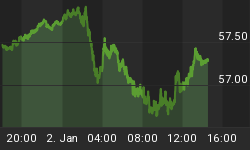The good news is:
• The weakness that began last week is part of a typical patternthat should end around October 1.
The first hint of trouble came on Tuesday when the most of the major indices rose to a multiyear highs and NASDAQ new highs declined from 222 to 198. In an up market new highs normally increase on up days.
The new high indicator (NH) is a 10% trend (19 day EMA) of new highs.
The chart below shows the Russell 2000 (R2K) in red and NH in green. NH has been calculated from the component issues of the R2K over the previous 6 weeks instead of 52 weeks as reported by the exchanges.
The chart covers the past year, there are dashed vertical lines drawn on the 1st trading day of each month. The red dashed vertical line represents the 1st trading day of the year.
The pattern of two peaks in NH, the first in mid-June and the second in early July is similar to the NH pattern of mid-November - early December. After the 2nd peak NH fell off for a month as the index rose to new cycle highs and then collapsed. There is a seasonal difference; January during the 1st year of the presidential cycle is typically strong while August is typically weak.

The next chart is similar to the one above except the index is the S&P 500 (SPX) and NH has been calculated from the component issues of the SPX. Since the recent rally began in late April SPX NH was weaker than NH calculated from R2K issues. This pattern is unusual in that it is usually the blue chips that make the final show of strength. Perhaps there will be another run for the blue chips.

Summation indices (SI) are running totals of oscillator values. The chart below shows the NASDAQ composite (OTC) in red along with SI's calculated from oscillators generated from NASDAQ advances - declines, new highs - new lows and upside - downside volume. SI's are good intermediate term indicators and they all turned downward last week.

The next chart shows the OTC in red and NH calculated from NASDAQ reported new highs in green. Unlike the previous charts there was no deterioration of NH in the days prior to the decline that began on Wednesday. There was a larger scale non-confirmation in that NH was lower at the multiyear high of last week than it was in early December of last year when the OTC was at a lower level.

The last chart is similar to the previous one except that it covers a little over 3 years. The dashed vertical lines are drawn at the 1st trading day of each year. NH peaked with the price high about 1.5 years ago. The two marginally higher tops of the past 1.5 years have been accompanied by lower levels of NH meaning that fewer issues have been lifting the index to its higher highs. This narrowing of leadership is a common topping pattern. If the typical seasonal pattern holds, there should be a dip from now until the end of September followed by a rally to another new high next March.

During the 1st year of the presidential cycle the market, on average peaks on the 5th trading day of August, which was last Friday. That peak came 3 days early.
The deterioration last week caused most of the short and intermediate term indicators to turn downward.
I expect the major indices to be lower on Friday August 12 than they were on Friday August 5.
Last weeks optimistic forecast based on the strong seasonal characteristics of the 1st week of August during the 1st year of the presidential cycle was a miss.
This report is free to anyone who wants it, so please tell your friends.
If it is not for you, reply with REMOVE in the subject line.
















